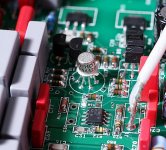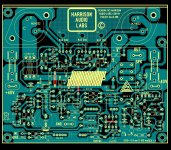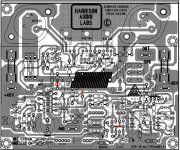Okay Onaudio you have captured the attention of some of the knowledgeable members - you still need a few more, then what do we do - first pull the design apart so that everyone is on the same page understanding what you objective is? and then what?
I honestly doubt if you will get 32K responses. What about the amp would you consider significantly better (yes actually different but leaning to better. Then again better than what. There are a few very accomplished members here that have deigns bordering on the best - to them anyway.
I think you would have to explain the methodology in order to get co-operation as well as what you want people to respond to.
You would have to define how one needs to respond and which adjective carry what weight, etc.
At this point in time you are hanging by one foot over the side of the boat and you better think of taking a deep breath.
I honestly doubt if you will get 32K responses. What about the amp would you consider significantly better (yes actually different but leaning to better. Then again better than what. There are a few very accomplished members here that have deigns bordering on the best - to them anyway.
I think you would have to explain the methodology in order to get co-operation as well as what you want people to respond to.
You would have to define how one needs to respond and which adjective carry what weight, etc.
At this point in time you are hanging by one foot over the side of the boat and you better think of taking a deep breath.
Interesting thread...
Adding an OPA134 buffer stage before the power amplifier is not new. I have seen it before and always wonder why they did it. Here it can be seen in the Metis 3 from Goldmund.... I did guess that it only was a way to save the rare "2N5565 from beeing damage by the user.
Adding an OPA134 buffer stage before the power amplifier is not new. I have seen it before and always wonder why they did it. Here it can be seen in the Metis 3 from Goldmund.... I did guess that it only was a way to save the rare "2N5565 from beeing damage by the user.
Attachments
I'm still trying to figure out what's the "magic juju" in this schematicI can't find anything noteworthy that would be the result of an "applied formula". The only thing a lil different are the staged reference voltages for the CCS' but beyond that..
True art tries not to attract attention in order to be noticed.
Jose Bergamin.
Let your ears be the judge
Okay Onaudio you have captured the attention of some of the knowledgeable members - you still need a few more, then what do we do - first pull the design apart so that everyone is on the same page understanding what you objective is? and then what?
I honestly doubt if you will get 32K responses. What about the amp would you consider significantly better (yes actually different but leaning to better. Then again better than what. There are a few very accomplished members here that have deigns bordering on the best - to them anyway.
I think you would have to explain the methodology in order to get co-operation as well as what you want people to respond to.
You would have to define how one needs to respond and which adjective carry what weight, etc.
At this point in time you are hanging by one foot over the side of the boat and you better think of taking a deep breath.
Dear Nico,
We are all after the same thing
Interesting thread...
Adding an OPA134 buffer stage before the power amplifier is not new. I have seen it before and always wonder why they did it. Here it can be seen in the Metis 3 from Goldmund.... I did guess that it only was a way to save the rare "2N5565 from beeing damage by the user.
Hi Tommy,
The OPA134 is TI s gem, Its there by its own right... it is highly probable that the formula TI is using is a subset of my formula
Using an opamp as an input device has two reasons: To provide the common line impedance of 47K at the input while having the strength to drive relative low impedance IPS. Secondly, the opamp can be given gain in order to reduce SNR of the amp itself, running 2Vpeak instead of 1Vpeak. This means less CFB gain which increases available bandwith. All in all nothing too special here.
@OnAudio: I'm not going to "blindly" build some amp without someone explaining design intent and how he/she went about about achieving said design intent. You're evading any such questions about your amp. How could you expect someone to just go and build it, much less 30K people?
@OnAudio: I'm not going to "blindly" build some amp without someone explaining design intent and how he/she went about about achieving said design intent. You're evading any such questions about your amp. How could you expect someone to just go and build it, much less 30K people?
Using an opamp as an input device has two reasons: To provide the common line impedance of 47K at the input while having the strength to drive relative low impedance IPS. Secondly, the opamp can be given gain in order to reduce SNR of the amp itself, running 2Vpeak instead of 1Vpeak. This means less CFB gain which increases available bandwith. All in all nothing too special here.
@OnAudio: I'm not going to "blindly" build some amp without someone explaining design intent and how he/she went about about achieving said design intent. You're evading any such questions about your amp. How could you expect someone to just go and build it, much less 30K people?
Hi Magic Box,
The objective of this project is to share a good amplifier as well as get user feedback to update both the amplifier and the model it is based on.All this will hopefully improve the state of the art
Onaudio, are you a psychology major?
Anyway, in one of the early comments, I responded regarding the op-amp preceding the amp that it sounded different good.
But when I re-listen my own amps without the addition it also sounds different good. I see the addition of the unusual cap, resistor configuration as the main contribution of the different sound.
With due respect, there is nothing spectacular or ingenious about the amp design that would make it better or worse than any other good design. I have simulated it and the harmonic distribution, the phase change, slew, etc. is no better nor worse than most of the "good" designs offered on the forum.
So what do you need us to comment, give the adjectives and explain what you need them to define because we are talking subjective so we all need to be on the same page with definitions else they are meaningless.
If you need us to confirm degrees of transparency, fast, clear, clinical or whatever, then define what the meaning of each word is and how to score it to be meaningful to you.
At the moment your request is very ambiguous and how you want to receive a response is nebulous at present.
Anyway, in one of the early comments, I responded regarding the op-amp preceding the amp that it sounded different good.
But when I re-listen my own amps without the addition it also sounds different good. I see the addition of the unusual cap, resistor configuration as the main contribution of the different sound.
With due respect, there is nothing spectacular or ingenious about the amp design that would make it better or worse than any other good design. I have simulated it and the harmonic distribution, the phase change, slew, etc. is no better nor worse than most of the "good" designs offered on the forum.
So what do you need us to comment, give the adjectives and explain what you need them to define because we are talking subjective so we all need to be on the same page with definitions else they are meaningless.
If you need us to confirm degrees of transparency, fast, clear, clinical or whatever, then define what the meaning of each word is and how to score it to be meaningful to you.
At the moment your request is very ambiguous and how you want to receive a response is nebulous at present.
Last edited:
Onaudio, are you a psychology major?
Anyway, in one of the early comments, I responded regarding the op-amp preceding the amp that it sounded different good.
But when I re-listen my own amps without the addition it also sounds different good. I see the addition of the unusual cap, resistor configuration as the main contribution of the different sound.
With due respect, there is nothing spectacular or ingenious about the amp design that would make it better or worse than any other good design. I have simulated it and the harmonic distribution, the phase change, slew, etc. is no better nor worse than most of the "good" designs offered on the forum.
So what do you need us to comment, give the adjectives and explain what you need them to define because we are talking subjective so we all need to be on the same page with definitions else they are meaningless.
If you need us to confirm degrees of transparency, fast, clear, clinical or whatever, then define what the meaning of each word is and how to score it to be meaningful to you.
At the moment your request is very ambiguous and how you want to receive a response is nebulous at present.
Hi Nico,
Simulations don't tell the entire story . The music, the amplifier, the transducers, the air, your ears, your soul come together to create one potent mixture of passion just like the buffer did for you . Nico its time to make this happen.
Let me narrow down my expectations and terms. Taking a set of n amplifiers which you own, how many times in time t would you pick this one ?
kind regards,
Harrison.
Hi, OnAudio
What is the secret?
Hi Michael, no this is a standard darlington configuration used in a TEF. The difference is this transistor is one of the thougher cookies in the jar and well suited for high current drive and DC motor control. It would mimic on quick guess 6 x MJ15003 paralel connected output devices crammed into a single package making matching unnecessary. It could contribute much of the output character of the amplifier relating to brute force and very low output impedance, However it is by far no magical formula for success.
Hi Michael, no this is a standard Darlington configuration used in a TEF. and a quasi complimentary matching pair.The difference is these transistor are some of the tougher cookies in the jar and well suited for high current drive and DC motor control. It would mimic on quick guess >6 x MJ15003 parallel connected output devices crammed into a single package making matching unnecessary. It could contribute much of the output character of the amplifier relating to brute force and very low output impedance, However it is by far no magical formula for success. What can be considered is it high gain of around 1000, to a VAS running at low current would reveal a pretty wide band operation and I would guess at least several MHz. The High Gain Bandwidth product call for serious feedback that needs be employed and this will extend the linearity significantly. It is a promising design though with little comments needed as he took care in his design.
There is a great following for the sound of quasi complimentary amplifiers since it is said that the top and bottom half have identical characteristic and arbitrary steps in harmonic generation is well controlled. Although I would like to hear the amp perform in my current system, I do not have the time and inclenation to do it in the next few days.perform. Unfortunately to justify proper comparison one has to follow the same build quality as the specimen that you intend to compare with, else the outcome can be skewed.
On RAS-ELD, I spent nearly $ 40K to achieve what I wanted to and it took me several years of R&D but the outcome justifies the expense and effort totally. Now to me to build a second amplifier, which has to be at least technically on par would cost me around another $ 15K or more and possibly be disappointing as I am not sure that I would achieve anything other than remaining at what I have.
One cannot compare apples with apples unless they are at least given the same love and care creating them such as a stiff non-resonant machined chassis. A purpose made power supply so that the amplifiers will be capable of the exact same performance electrically and mechanically. It would be easy for someone to compare a cheap protortye to another in a week-end, but to bring a new design up to my standard is a major feat.
If one is content with just a mediocre set-up to find which one is less mediocre that would be defeating the object and to compare a best of the best situation defeats the finances especially if there is no commercial incentive.
I have two RAS-ELDs. The one had the front end modified with the capacitor resistor network and the other retains my Linkwitz Railey equalizer and my comparison would be done between two identical hi-performance amplifiers each having it different front end. These amplifiers are dual-differential topology, similar to Goldmund/Toshiba/Others with eight lateral MOSFET devices running at 70V and driver stage running off 100V.
If you would be kind enough to give me the magic words to use and their meaning as well as their weighting factor, I would most happily comply with your request, since I am totally convinced that it is only the input network that would modify the sound somewhat to being more or less enjoyable.
I am participating only to try and get to your algorithm and prediction, else I would not have even gone this far. I have a few other amplifiers that I can do the same modification to, but my intention is to use the best, then there cannot be other arguments.
I trust this will be adequate
There is a great following for the sound of quasi complimentary amplifiers since it is said that the top and bottom half have identical characteristic and arbitrary steps in harmonic generation is well controlled. Although I would like to hear the amp perform in my current system, I do not have the time and inclenation to do it in the next few days.perform. Unfortunately to justify proper comparison one has to follow the same build quality as the specimen that you intend to compare with, else the outcome can be skewed.
On RAS-ELD, I spent nearly $ 40K to achieve what I wanted to and it took me several years of R&D but the outcome justifies the expense and effort totally. Now to me to build a second amplifier, which has to be at least technically on par would cost me around another $ 15K or more and possibly be disappointing as I am not sure that I would achieve anything other than remaining at what I have.
One cannot compare apples with apples unless they are at least given the same love and care creating them such as a stiff non-resonant machined chassis. A purpose made power supply so that the amplifiers will be capable of the exact same performance electrically and mechanically. It would be easy for someone to compare a cheap protortye to another in a week-end, but to bring a new design up to my standard is a major feat.
If one is content with just a mediocre set-up to find which one is less mediocre that would be defeating the object and to compare a best of the best situation defeats the finances especially if there is no commercial incentive.
I have two RAS-ELDs. The one had the front end modified with the capacitor resistor network and the other retains my Linkwitz Railey equalizer and my comparison would be done between two identical hi-performance amplifiers each having it different front end. These amplifiers are dual-differential topology, similar to Goldmund/Toshiba/Others with eight lateral MOSFET devices running at 70V and driver stage running off 100V.
If you would be kind enough to give me the magic words to use and their meaning as well as their weighting factor, I would most happily comply with your request, since I am totally convinced that it is only the input network that would modify the sound somewhat to being more or less enjoyable.
I am participating only to try and get to your algorithm and prediction, else I would not have even gone this far. I have a few other amplifiers that I can do the same modification to, but my intention is to use the best, then there cannot be other arguments.
I trust this will be adequate
- Status
- This old topic is closed. If you want to reopen this topic, contact a moderator using the "Report Post" button.
- Home
- Vendor's Bazaar
- Combined Onaudio thread. (23 threads)



